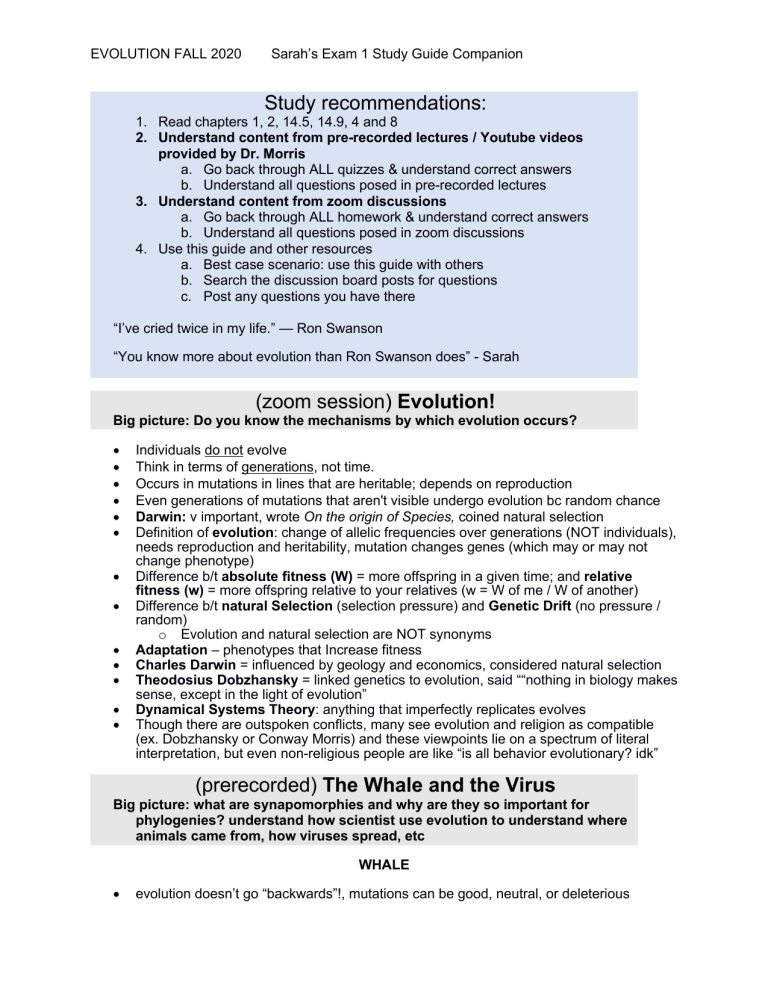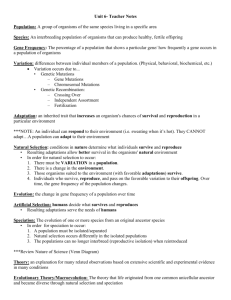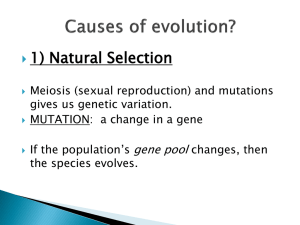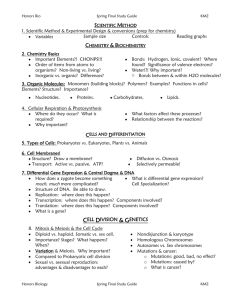
EVOLUTION FALL 2020 Sarah’s Exam 1 Study Guide Companion Study recommendations: 1. Read chapters 1, 2, 14.5, 14.9, 4 and 8 2. Understand content from pre-recorded lectures / Youtube videos provided by Dr. Morris a. Go back through ALL quizzes & understand correct answers b. Understand all questions posed in pre-recorded lectures 3. Understand content from zoom discussions a. Go back through ALL homework & understand correct answers b. Understand all questions posed in zoom discussions 4. Use this guide and other resources a. Best case scenario: use this guide with others b. Search the discussion board posts for questions c. Post any questions you have there “I’ve cried twice in my life.” — Ron Swanson “You know more about evolution than Ron Swanson does” - Sarah (zoom session) Evolution! Big picture: Do you know the mechanisms by which evolution occurs? • • • • • • • • • • • • • Individuals do not evolve Think in terms of generations, not time. Occurs in mutations in lines that are heritable; depends on reproduction Even generations of mutations that aren't visible undergo evolution bc random chance Darwin: v important, wrote On the origin of Species, coined natural selection Definition of evolution: change of allelic frequencies over generations (NOT individuals), needs reproduction and heritability, mutation changes genes (which may or may not change phenotype) Difference b/t absolute fitness (W) = more offspring in a given time; and relative fitness (w) = more offspring relative to your relatives (w = W of me / W of another) Difference b/t natural Selection (selection pressure) and Genetic Drift (no pressure / random) o Evolution and natural selection are NOT synonyms Adaptation – phenotypes that Increase fitness Charles Darwin = influenced by geology and economics, considered natural selection Theodosius Dobzhansky = linked genetics to evolution, said ““nothing in biology makes sense, except in the light of evolution” Dynamical Systems Theory: anything that imperfectly replicates evolves Though there are outspoken conflicts, many see evolution and religion as compatible (ex. Dobzhansky or Conway Morris) and these viewpoints lie on a spectrum of literal interpretation, but even non-religious people are like “is all behavior evolutionary? idk” (prerecorded) The Whale and the Virus Big picture: what are synapomorphies and why are they so important for phylogenies? understand how scientist use evolution to understand where animals came from, how viruses spread, etc WHALE • evolution doesn’t go “backwards”!, mutations can be good, neutral, or deleterious EVOLUTION FALL 2020 • • • • • • • Sarah’s Exam 1 Study Guide Companion Are whales fish? no! How do we know? stuff like Synapomorphies, a derived trait from the ancestor, ex. involucrum How’d scientists figure out the connection between cetaceans (marine mammals) and land mammals? not just the involucrum but also the astragalus (ankle bone) of the cetacean pakicetus which was a synapomorphy of other land dwellers. o Hippo = land dweller close living relative of whale How did cetaceans (like whales) lose their legs? Relaxed selection and accumulation of mutations Homologies have derived traits from same ancestor (ex. mammal ankle bones) o Ex. Human fingers and bat wing bones analogies have traits of similar functions from different origin lineages (wing of fly of wing of bat—not made of same stuff but serve similar function) Phylogenetic trees are used to show relationships between organisms, where a node = a synapomorphy and a clade is group of organisms that occur past node o phylogenetic tree = evolutionary family tree o According to your textbook, what drove the evolution of large, powerful brains in dolphins? Living in large social groups Vestigial – derived adaptation no longer suited to serve in environment VIRUS • • • • • Hemagglutinin (spikey) and Neuraminidase are the outer proteins in the HN viruses, which are antigens harbing pathogen associated molecular patterns when infecting the human immune system o H and N = The antigen proteins that help the virus bind to respiratory cells why do viruses with beneficial mutations increase through frequency? natural selection Antigen drift = (good/neutral/bad) mutations over time o The slow and steady accumulation of genetic changes in flu genomes over time Antigen shift = mutations suddenly (HGT) Viral assortment = viruses from different species can all get into one host and recombine DNA (zoom session) The Replicator Big picture: What does Dawkin’s mean about a replicator and what implications does the replicator thing have on studying evolution? from HW #1: stability (life is lazy, doesn’t want to be unstable) vs fitness (offspring production and their viability; miscopying can increase stability). replicator needs longevity (don’t die before you reproduce), fecundity (amount of offspring/time), and accuracy/fidelity (some mistakes are v bad). modern example of replicator = ribozymes • • • • Dawkins: wrote selfish gene, idea of autonomous replicator "Evolution as Survival of the Stable" – general umbrella law that describes survival of the fittest, everything has a preferred/ideal shape for its environment Components of fitness for Dawkins' replicator (see HW1) The idea of "the survival machine"-- replicators use neg feedback to achieve control of their organisms. creatures as gene robots, weird but ok??? EVOLUTION FALL 2020 Sarah’s Exam 1 Study Guide Companion (prerecorded) Deep Time: Geologic Record Big picture: how do we know how old the earth is and how old fossilized d organisms are? • • • • • • • • • • Catastrophism (big catastrophe) vs. uniformitarianism (compound interest, same science forces long ago and today); neither is completely right famous ppl: Carolus Linnaeus: “father of modern taxonomy”; Carle Woese: pioneer of molecular genetics like using 16s rRNA gene, George Cuviers (fossils aren’t like bones of creatures living in today bc things went extinct, paleontology) , James Hutton (uniformitarianism), Charles Lyell (Principles of Geology book Darwin read), William Smith (geological strata/The Principle of Faunal Succession = rock strata contain fauna in a measurable timely order) dating fossils is v important Taxonomic classification: Domain, Kingdom, Phylum, Class, Order, Family, Genus, Species; Taxa: DKPCOFGS; Taxon = related by similarity by descent geological periods: Cambrian, Ordovician, Silurian, Devonian, Mississippian, Pennsylvanian, Triassic, Jurassic, Cretaceous, Paleogene, Neogene, Quaternary. The geological aeons: Hadean 4.6-3.9bya (v hot), Archaean 3.9 bya – 2.5 bya (cool continents, archaea/cyanobacteria), Proterozoic 2.5 bya – 0.6 bya, longest (fossils, wow), Phanerozoic 0.6 – current (“complex” life, started with Cambrian explosion) Scientists use fossil evidence, fossil/ rock chemical analysis (study isotopes) as well as genetics to assess relatedness in evolution Radioisotopes: unstable isotopes decay into daughter isotope using half-life, or time it takes parent to decay by 50%; in this way you can calculate how old something is How do we date Earth stuff? radioactive dating/rock strata, fossil remnants of multicellular organisms, trace fossils, molecular markers --oxygen bands (show photosynthesis occurred) and molecular compounds, stable isotopes what period did rock come from = how old is it? use the formula for time t = -1.44 (half life) ln (parent / (parent + daughters) . this formula needs to be rearranged if for whatever reason you’re solving for % of parent isotope where Nt = No * e (-0.69 *time / half life) Skill: Interpret isotope ratio data (prerecorded) Deep Time: Tools of Evolutionary Biology Big picture: how do scientists study evolution? • • • • • • • • • evolution is conservative and can be resistant to mutation-- Most mutations are removed by natural selection Trace fossils = soft-animal traces, are they really “fossils”? who knows Biomarker – biologic indicator that shows traces of life/state (ex. steroids like hopanoids or okenane), banded iron formations in rocks show high to low O in earth’s history Stromatolite – formed by layer of cyanobacteria, provide records of Earth Abigail Allwood= Uses stromatolites in the Australian Outback to study the deep history of life radioisotope = decays spontaneously stable isotope = doesn’t decay, enzymes prefer light stable isotopes, found old carbon isotope ratio in historic crystal (13C:12C ratio) Explain why Woese’s use of the 16s rRNA gene is so important to molecular phylogeny!! EVOLUTION FALL 2020 Sarah’s Exam 1 Study Guide Companion (prerecorded) Deep Time: Major transitions Big picture: what’s been happening on earth for all these millions of years? • • • The geological aeons (again but in more detail: o Hadean = Asteroid impacts prevented Earth's crust from solidifying 4.63.9bya (v ho hellisht), lots of asteroids, no crust but LIFE! o transition: asteroids stop, crust! rocks! cool! o Archaean = Growth of life was limited by the availability of reduced chemicals 3.9 bya – 2.5 bya (life, photosynthesis begins, neat, plus chemolithoautrophy (how metal!!), but where the electrons at????), o transition: oxygen! cyanobacteria! oh my! o Proterozoic = Begins with the Great Oxygenation Event 2.5 bya – 0.6 bya, longest (things can breath O now, eukaryotes, things get wild) o transition: big stuff appears! very cold “snowball earth” maybe? is this when stuff actually differentiated? now we have animals & land plants o Phanerozoic = Begins with the Cambrian Explosion 0.6 – current (“complex” life) § eras change bc stuff went extinct § Late-Permian: Large Igneous Provinces / Siberian Trapsà methane à happy bacteria à sad ocean Paleozoic Ends with the eruption of the Siberian Traps § Mesozoic the collision of a single giant asteroid with the Earth, KT extinction: not as bad but still bad because no more dinos. because of an asteroid, probably, less diatoms which is the real tragedy, but now there’s more mammals, birds, flowers, insects § Anthropocene: humans, what are we even doing to this planet L Anagenesis is when things change gradually and become (think the “march of progress” picture. in reality, things speciate) Ex. A shelled organism's shape gradually changes over thousands of years until it barely resembles the fossils of its ancestors, leading paleontologists to call it a different species from its ancestor. This is an example of: anagenesis o evolution IS NOT “gradual”, it’s actually punctuated (Gould) diversification in new niches is called adaptive radiation. Ex. The rapid proliferation of new species following a mass extinction is an example of: adaptive radiation (zoom session) The Tape of Life Big picture: Why was the Burgess Shale super important? Be able to argue on behalf of Gould vs. Conway Morris. from HW #2: Stephen Jay Gould = evo is unpredictable (BS v important bc it paved the way for orgs on Earth now); Conway Morris = evo is predictable, would get human-like orgs inevitably (convergent evolution; BS is not v important bc it would all be the same now anyway). Be able to argue on behalf of Gould vs. Conway Morris on a given evolved form! • • • external impacts & chemical changes create new environments for different types of species to thrive What is Anomalocaris? famous people: Whittington and Briggs (argued that anomalocaris Cambrian fossils were 1 weird extinct animal, not many recognizable orgs) Burgess Shale –(BS) some rocks in Canada, 505 ma (Cambrian), Lagerstätten (perfect soft fossil preserving conditions like clay), hella diverse, EVOLUTION FALL 2020 • • • • Sarah’s Exam 1 Study Guide Companion The March of Progress – suggests linear/ladder, suggests evolution is progressive Diversity (many different # of species) vs. disparity (specialization difference among taxa); disparity of life vs. time graphs. inverted cone = Gould; stepwise regular cone = Conway Morris "The Great Chain of Being" - hierarchical structure of all matter and life Contingency (chance) – opposite of determinism (things are already decided (prerecorded) Tree Thinking and Phylogenetics 1-3 (zoom session) Caminacules Big picture: Interpreting phylogenetic trees, determine if a group like “fish” is a true taxonomic unit / clade; Can you interpret a data matrix with binary traits and recognize the best tree? • • • • • • • • • • • • • • • • phylogeny is based on common ancestry; tip (end) branch (line) root (origin line including out groups) node (dot/ represents common ancestry) outgroup (no common ancestor compared to other clades) clade (ALL DESCENDANTS OF 1 ANCESTOR) Synapomorphy = shared derived character state // they define clades; monophyletic (clade); paraphyly (clade + part of another clade); polyphyly = parts of 2+ clades) cladogram (only patterns and ancestry via topology) vs. phylogram (shows distance with branch length) vs. chronogram (shows time). yOu cAn RotATE a shared node w/o changing meaning lineages can be collapsible!!! valid taxonomic group = based on complete (sets of) clades Principle of Parsimony = usually (but not always) want analysis of homologous characters to be least parsimonious Homoplasy = when two derived nodes share character trait that common ancestor does not have. by 1) reversion (is reversion the “best” phrase? anyway this is when in the history of a species, it’s ancestors had a trait, but more modern ancestors lost it, but yet the species has it!!) 2) convergence (remember Conway Morris points? this is two species having a trait even though their common ancestor did not have it) and 3) HGT horizontal gene transfer (branched origin tree/ see: introgression with animals) Make consensus tree when many trees are = in parsimony, represent by polytomy consensus tree nothing is primitive! bacteria are just if not more evolved than us!!! Systematics – study of relationships between orgs (living and dead) over time Other key words: Maximum Likelihood tree; Bayesian tree How to bootstrap: calculate the % of trees that have the exact same monophyletic clade Skill: Calculate a bootstrap value for a clade from a collection of trees Skill: Construct a phylogenetic tree from a character matrix using the neighborjoining algorithm Skill: Calculate parsimony of a tree using a character matrix Skill: Identify homoplasy in a phylogenetic tree from HW #3: Caminalcules part– synapomorphies that define clades are phylogenetic markers/character traits an entire clade shares. living org species (Caminalcules) all have a separate node, can’t use one as a common ancestor bc they are like living orgs! HW 3 answers are online btw o (no anagenesisis!) = gradual morphological change without speciation o all taxa need to end at the end of branches o polytomy is a consensus tree/clade o every node connects 2 other nodes meaning they are dichotomously branching EVOLUTION FALL 2020 Sarah’s Exam 1 Study Guide Companion also, created distance matrix using character matrixes (binary), used that to create tree, recognize the best trees are usually least parsimonious, homoplasies: convergence = 2 orgs derived some function w/o common ancestor with trait; HGT/introgression: sharing of genes before species split; reversion: derived ancestor had trait, more modern ancestor did not, species has It again (prerecorded) Molecular Phylogenetics 1-2 Big picture: how do scientists use phylogenetic trees to study molecular relationships? How do types of mutations affect evolution? • • • • • • • • • • how do you know morphological traits are heritable? but cryptic species are sneaky (cryptic species are different species that are morphologically identical) characters in matrix can be: morphological binary, DNA, or AA from protein the source of phenotype is genotype so using dna to build trees is sensible o but it can tricky because maybe not all the aligned sequences make up the same gene o subfunctionalism: derived duplicated gene has LESS function than ancestor o NEOfunctionalism: derived duplicated gene creates a new function can assess heritability using molecular phylogenetics—from molecular data, can see sequences are homologous if they are all the same. pros: can use computers to compare lots of characters, not as ambiguous as binary traits, can compare stuff that doesn’t share morphological traits (like trees and humans) characters in matrix can be: morphological binary, DNA, or AA from protein cons: homoplasy everywhere , alignments can be tricky because you don’t always know what is non-coding and whatnot, needs a lot of computing power like a super computer (not sure if my little old laptop could handle it) is probability of transitions and transversions the same? o transition: purine to purine (ex. A to G) OR Pyrimidine to pyrimdine (ex. C to T) o transversion: purine to pyrimidine OR pyrimidine to purine (ex. C to A) o lots of models to figure this out that incorporate the frequency for the bases, sites that don’t change (called I), and rate variation (called G); examples: JC, HKY, GTR, GTR+I+G, all use different levels of “free parameters” and assumptions o In class example was using HKY to just show that it assumes some transitions must have occurred through homoplasy even though those direct changes weren’t observed o evolutionary biologists actually use a mix of methods other notes I have from genetics/ Ch 6 that may be helpful: mutations = missense (no effect), nonsense (creates stop), and frameshift (insert, delete, duplication), not always heritable, proks have < genetic waste than euks. Coalescence – back in time from present go backward to see how alleles from population originated from common ancestor; when allele first appears it’s the only one of its kind! vs going forward in time: spread / diffuse / invade (called “fixed” if allele spreads to 100% of population, “selectively sweeping” out the other alleles due to higher “fixation time” than coalescent time) o genes have different coalescence à different evo history o explain why this means why there is a non-human common ancestor of humans on the gene level (hint: what’s different between “Y chromosome adam” and “mitochondrial eve”? o fixation time can be lowered if there are small pop sizes, stronger natural selection, and less sexual recombination (can you explain why? ex. well if the pop is infinitely big, it will be very hard for one allele to dominate!) EVOLUTION FALL 2020 Sarah’s Exam 1 Study Guide Companion in sexual species, hitchhiking alleles on the same chromosome can be fixed along with the selective sweeping allele o sweeping can basically end loci allele diversity § example: adult lactose gene Lac (how is this also an example of convergent evolution?) ILS, incomplete lineage sorting, there’s some polymorphism for a brief spell but we can’t tell by just looking at a simplified tree. o this is why it’s so important to build phylogenies on many many genes o why is this false? Incomplete lineage sorting can only happen when the gene tree and species tree are exactly the same. o but which genes should you use? slower evolving ones = better for distantly related sp., rapidly evolving genes better for closer related sp. (why?) o why are ribosomal genes so useful for studying ancient relationships? o why are microsatellites so useful for studying human relationships? Motoo Kimura – “neutral theory” due to drift, neutral substitutions are predictable via molecular clocks, supported by data in cytochrome c gene, synonymous mutation (doesn’t change protein/neutral/drift), non-synonymous (changes protein L) person Synonymous mutations _____________. The rate of synonymous substitutions in a gene serves as an estimate of the rate of ___________. (Fill in the blanks). do not change the amino acid sequence of the protein; neutral evolution by genetic drift If you compare Non-synonymous to synonymous (dN/dS) and it’s faster (>1), we call it positive selections. if it’s slower <1), it’s called purifiying selection. if they are the same, it’s b/c of drift. o evolution rates different based on type of DNA (which one is faster, nonsynoymous, synonymous, introns, etc?) o if there are more synymous mutations, did selection happen? o why do you say a dn/ds of 0 is evolutionary conservation in action? Determine if selection is working on a DNA sequence based on dN/dS ratio Compose a distance matrix and neighbor-joining tree from DNA sequence data o • • • • • • • • (prerecorded) Computational Evolution 1-2 Big picture: How do our views of evolution apply to computers? Why and how would you use evolutionary computation? Can you talk about how to do it in a novel situation? how would you explain how computer viruses are alive? Break down a problem into modules and suggest a genetic algorithm to solve the problem • • • • • (Genetic) Algorithm – optimize things in evolution, needs “organism” and fitness fxn online “fitness” is measured by how good the solution is genes = modular bits, all of evolution basically work in these algorithm modules process: imagine lots of possible solutions à better solutions have higher fitness à assign genome values in range à iterate again and again by MATING more fit solution o ex. showed an algorithm being mated by just averaging fit solutions together o goal: increase fitness, based on minimizing error (think super Mario video or boxcar2d) when to use computational evolution: idk how data set is structured, no idea how to start problem, when there’s a lot of okay solutions (rugged fitness landscape), to get past biases of ppl/engineers (you don’t know superior solutions if the same ppl have been working on problem forever) EVOLUTION FALL 2020 Sarah’s Exam 1 Study Guide Companion • Polymorphic code ~ viruses can change detection based on which code they use! tricky tricky. Ex. Bagle botnet infected a quarter of a million computers; tried to outpace antivirus software • • Cellular automata - discrete model, cells in grids with finite # of states Game of Life - Jon Conway, first cellular automation; Jon Simon Conway, he made a novel electronic “game of life”, has rules (see ruls on slide 7 of lecture 6b) and landscape Darwin – Bell labs, best programs could change their own code, players made code meant to defeat each other’s code Core Wars – like Darwin but 2 programs want control of computer, programs tried to actually conquer entire processor Tierra – computer systems compete for CPU / time and space, Tom Ray, programs could actually mutate themselves to win, note: these ARE evolution, not just a simulation AVIDA – nerds from Caltech, Avidians = cells, uses 0,1 code & Logic Gates, Tierra/AVIDA aren’t “like” evolution, they are evolution (mutation, selection, Logic Gates), Chris Adami/Charles Ofria/Titus Brown – made AVIDA, used to study selfreplicating computer organisms In class activity: Run AVIDA, see how chance mutations allowed 1 organism to overcome other 7 organisms (random chance/ genetic drift), and how “antibiotic” selected for “NOT gene” once “NOT gene” was present (natural selection), toggle between fitness and organisms map • • • • • (zoom session) Phylogenetics and Computational Evolution Recap BoxCar 2D running / evolving in background. what’s the cars “chromosome”? Boxcar2d.com algorithm takes forever to make a good boxcar lol convergence in boxcars: many have 2 wheels, neat looking at previous trees from HW4: do not have anagenesis in your tree, make sure you can make a neighbor joining tree from a matrix make a paper airplane. Modules= # of folds/position, size/type of paper; Fitness = distance flying/accuracy/time in air? what is the problem? what is “fitness”? how does it “evolve”? break into modules, so don’t make the airplane you think will work first, you have to start from random selections and mutations!! This slide 21 from lecture 6a should help you apply evolutionary thinking to any problem!





